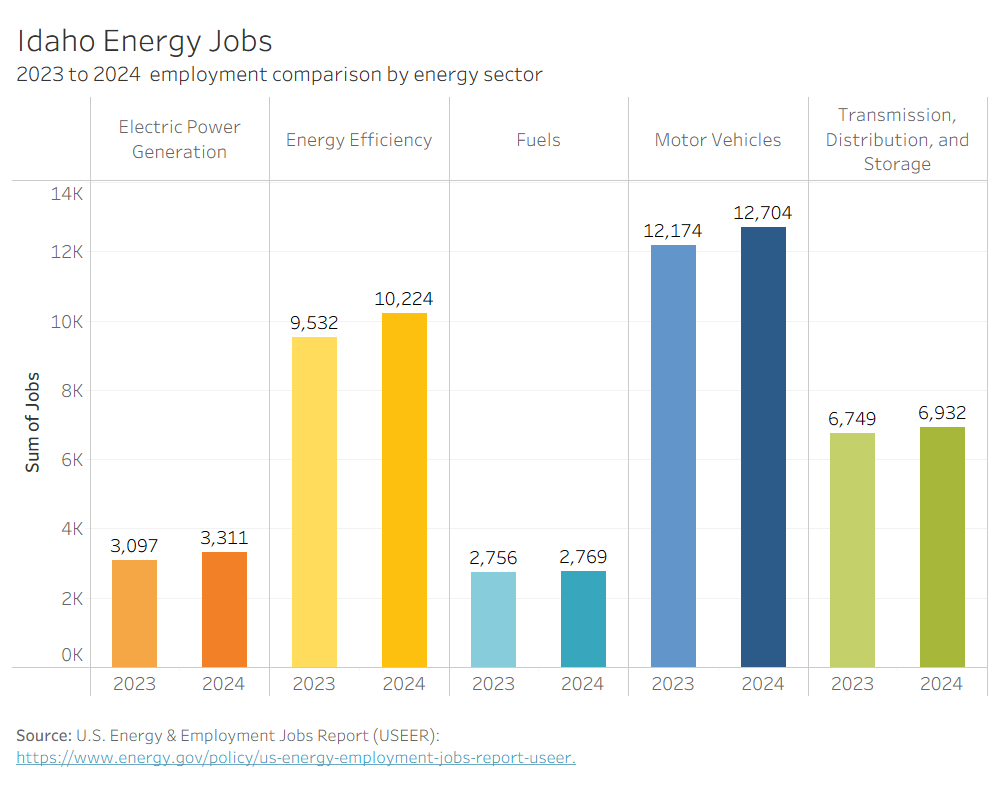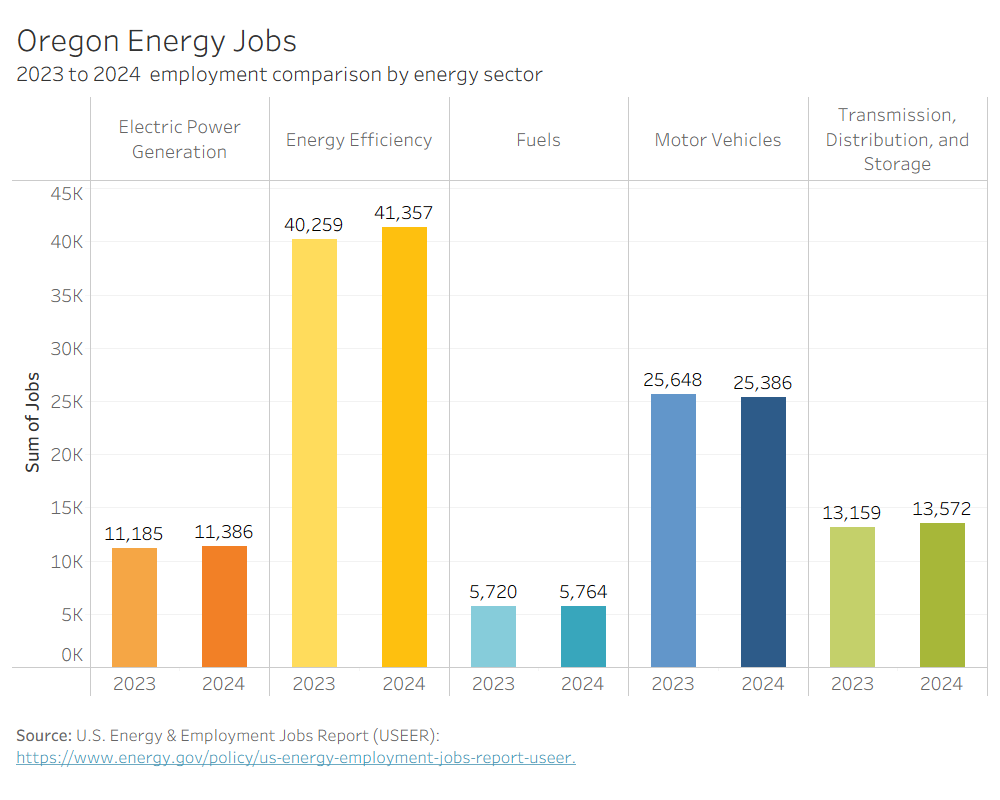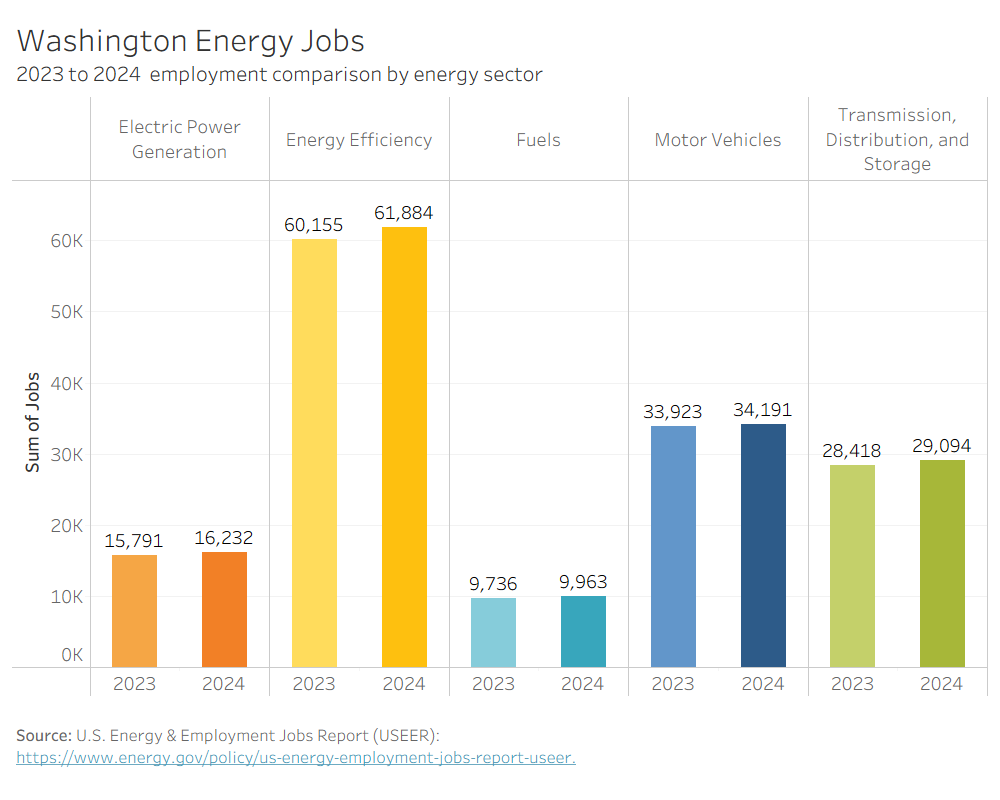
As previous Clean Energy Transition Institute research shows, the clean energy transition has the potential to bring job growth to the Northwest. At the same time, there will likely be job displacement in fossil fuel-related fields. Tracking energy workforce trends from year to year allows us to see how the transition is unfolding and where support is needed to make it equitable.
The U.S. Department of Energy’s (DOE) Office of Energy Jobs has contracted with BW Research since 2016 to produce the United States Energy & Employment Report (USEER) to provide information about national, state, and county-level energy jobs. The annual report draws on data from the Bureau of Labor Statistics and surveys of U.S. energy sector employers. The final report includes data by industry, technology, and region, including information on unionization rates, demographics, and employer perspectives on growth and hiring.
The 2025 USEER, released in August, reports on all energy employment data from 2024.1 Energy jobs are categorized into five technology areas, or sectors:
In past years, the USEER has also included a section on clean energy jobs, including statistics and national trends on clean energy job growth, employment data, and more. However, the 2025 USEER does not have a clean energy section, so instead this blog relies on E2’s Clean Jobs America 2025 report for these insights.
E2 is a national, nonpartisan organization focused on creating environmentally and economically beneficial programs, policies, and companies across the U.S. For the past 10 years, they have published a Clean Jobs America report, which analyzes the USEER and underlying data to develop a clean energy workforce narrative, including key drivers of clean energy job growth across the country and specific sector and subsector employment trends.2
According to the USEER, energy jobs grew from 8.35 million jobs in 2023 to 8.5 million jobs in 2024, accounting for 5.4% of all jobs in the U.S.
According to the E2 Clean Jobs America 2025 report, clean energy jobs grew by 2.8% in 2024, an addition of nearly 100,000 jobs that outpaced job growth across the rest of the energy industry. E2’s full clean energy job classification and methodology can be found here.
The USEER reports that Idaho employed nearly 36,000 energy workers in 2024, representing a 4.7% increase from the previous year. According to the E2 Clean Jobs America 2025 report, Idaho also experienced the highest rate of clean energy job growth in the country in 2024 (6.1%). The energy sector in Idaho represents 4.1% of total state employment, including the following breakdown by sector (percentage increase from 2023 in parentheses):
The energy efficiency sector added the most jobs in 2024 with nearly 700 jobs, driven by increases in traditional HVAC and efficient lighting. Among electrical power generation jobs, solar and wind accounted for nearly 70% of jobs.

The USEER reports that Montana had approximately 33,200 total energy workers in 2024, a 2% increase from the previous year. According to the E2 Clean Jobs America 2025 report, Montana also experienced one of the highest rates of clean energy job growth in the country in 2024 (4.5%). Despite relatively low net job growth overall, Montana’s energy jobs represent 6.4% of total state employment, with the following breakdown by sector (percentage increase from 2023 in parentheses):
The energy efficiency sector grew the most in 2024, adding 314 jobs, with the high efficiency HVAC and renewable heating & cooling subsector contributing the most.

The USEER reports that Oregon had nearly 97,500 energy workers in 2024, up 1.6% from the previous year. According to the E2 Clean Jobs America 2025 report, Oregon also experienced 1.8% growth in clean energy jobs in 2024. Energy sector jobs in Oregon represent 4.8% of total state employment, with the following breakdown by sector (percentage increase from 2023 in parentheses):
The energy efficiency sector grew the most, adding over 1,000 jobs, with the efficient lighting subsector growing the most.

The USEER reports that Washington had nearly 151,400 total energy workers in 2024, a 2.3% increase from the previous year. According to the E2 Clean Jobs America 2025 report, Washington saw 2.4% growth in clean energy jobs in 2024. The energy sector in Washington represents 4.1% of total state employment, with the following breakdown by sector (percentage increase from 2023 in parentheses):
The energy efficiency sector grew the most, adding over 1,000 jobs, with the efficient lighting subsector and the high efficiency HVAC and renewable heating & cooling subsector growing the most.

Nationally, employers in nearly every energy sector reported that they experienced the most hiring difficulty due to a lack of experience, education, training or technical skills, and/or sufficient certifications. While these specifics are not available at the state level in the USEER 2025 Report, the USEER Public Data set includes a percentage breakdown by state of hiring difficulty across energy employers. For the four Northwest states, an average of 20% of employers in 2024 experienced very difficult hiring conditions4, a slight increase from 2023. Additionally, an average of 46% of employers did not hire at all in 2024, a slight decrease from 2023. Information about hiring difficulty between subsectors and industry is provided in more detail in the report.
While the USEER 2025 national report does not include clean energy jobs data, E2’s Clean Jobs America 2025 report provides us with a clearer picture of how the nation’s clean energy workforce is growing. These statistics, highlighted in the “National Clean Energy Trends” section above, show how important clean energy jobs are to the energy sector, making up a vast majority of new energy jobs added in 2024 (82%) and growing at a faster rate than any individual energy sector.
Recent federal policies, such as permitting freezes on renewable energy projects and revoked clean energy incentives, threaten this growth and impact job security for Americans, the national economy, and the health of our environment and communities.
The energy industry also faces equity barriers, with underrepresentation of workers of color and women across all sectors. The E2 Clean Jobs America report found that across clean energy-related jobs, Black, Latino, Asian and Indigenous workers are underrepresented relative to the general U.S. workforce, and women make up just 28% of clean energy workers. As reported in the 2025 USEER, a vast number of energy sector jobs also do not provide comprehensive healthcare coverage for their employees and their families, placing increased financial insecurity on low-income workers and their communities. Addressing these equity barriers will be essential to accelerate a just clean energy transition.
We invite you to explore the USEER data in three updated visualizations on the Northwest Clean Energy Atlas:
You can also find the 2025 USEER full report, executive summary, state reports, and data here.
To get CETI updates straight to your inbox, sign up for our mailing list.
1. See USEER 2025 Appendices for discussion of USEER methodology, including the report's definition of a qualifying energy firm and energy worker.
2. Refer to pages 3 to 4 of E2’s Clean Jobs America 2025 report for notes on methodology and clean energy job classification.
3. Alabama, Arkansas, Florida, Georgia, Kentucky, Louisiana, Mississippi, North Carolina, Oklahoma, South Carolina, Tennessee, Texas, Virginia.
4. Response categories included “very difficult hiring, somewhat difficult hiring, not at all difficult hiring, and did not hire.”